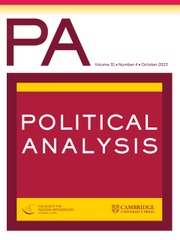Crossref Citations
This article has been cited by the following publications. This list is generated based on data provided by
Crossref.
Huddy, Leonie
Feldman, Stanley
Taber, Charles
and
Lahav, Gallya
2005.
Threat, Anxiety, and Support of Antiterrorism Policies.
American Journal of Political Science,
Vol. 49,
Issue. 3,
p.
593.
Lavine, Howard
Lodge, Milton
and
Freitas, Kate
2005.
Threat, Authoritarianism, and Selective Exposure to Information.
Political Psychology,
Vol. 26,
Issue. 2,
p.
219.
Cohrs, J. Christopher
Kielmann, Sven
Maes, Jürgen
and
Moschner, Barbara
2005.
Effects of Right‐Wing Authoritarianism and Threat from Terrorism on Restriction of Civil Liberties.
Analyses of Social Issues and Public Policy,
Vol. 5,
Issue. 1,
p.
263.
Stevens, Daniel
Bishin, Benjamin G.
and
Barr, Robert R.
2006.
Authoritarian Attitudes, Democracy, and Policy Preferences among Latin American Elites.
American Journal of Political Science,
Vol. 50,
Issue. 3,
p.
606.
Shim, Jae Woong
Lee, Seungwhan
and
Paul, Bryant
2007.
Who Responds to Unsolicited Sexually Explicit Materials on the Internet?: The Role of Individual Differences.
CyberPsychology & Behavior,
Vol. 10,
Issue. 1,
p.
71.
Merolla, Jennifer L.
Stephenson, Laura B.
and
Zechmeister, Elizabeth J.
2008.
Can Canadians Take a Hint? The (In)Effectiveness of Party Labels as Information Shortcuts in Canada.
Canadian Journal of Political Science,
Vol. 41,
Issue. 3,
p.
673.
Ramirez, Mark D.
2008.
Procedural Perceptions and Support for the U.S. Supreme Court.
Political Psychology,
Vol. 29,
Issue. 5,
p.
675.
Cohrs, J. Christopher
and
Ibler, Sina
2009.
Authoritarianism, Threat, and Prejudice: An Analysis of Mediation and Moderation.
Basic and Applied Social Psychology,
Vol. 31,
Issue. 1,
p.
81.
Canetti, Daphna
Halperin, Eran
Hobfoll, Stevan E.
Shapira, Oren
and
Hirsch-Hoefler, Sivan
2009.
Authoritarianism, perceived threat and exclusionism on the eve of the Disengagement: Evidence from Gaza.
International Journal of Intercultural Relations,
Vol. 33,
Issue. 6,
p.
463.
Hudson, Natalie Florea
and
Butler, Michael J.
2010.
The State of Experimental Research in IR: An Analytical Survey.
International Studies Review,
Vol. 12,
Issue. 2,
p.
165.
Thórisdóttir, Hulda
and
Jost, John T.
2011.
Motivated Closed‐Mindedness Mediates the Effect of Threat on Political Conservatism.
Political Psychology,
Vol. 32,
Issue. 5,
p.
785.
Hetherington, Marc
and
Suhay, Elizabeth
2011.
Authoritarianism, Threat, and Americans’ Support for the War on Terror.
American Journal of Political Science,
Vol. 55,
Issue. 3,
p.
546.
Kossowska, Małgorzata
Trejtowicz, Mariusz
de Lemus, Soledad
Bukowski, Marcin
Van Hiel, Alain
and
Goodwin, Robin
2011.
Relationships between right‐wing authoritarianism, terrorism threat, and attitudes towards restrictions of civil rights: A comparison among four European countries.
British Journal of Psychology,
Vol. 102,
Issue. 2,
p.
245.
Merolla, Jennifer L.
Ramos, Jennifer M.
and
Zechmeister, Elizabeth J.
2011.
Extremism and the Psychology of Uncertainty.
p.
212.
Lecheler, Sophie
and
de Vreese, Claes H.
2011.
Getting Real: The Duration of Framing Effects.
Journal of Communication,
Vol. 61,
Issue. 5,
p.
959.
Lodge, Milton
Taber, Charles
and
Verhulst, Brad
2011.
Cambridge Handbook of Experimental Political Science.
p.
155.
Gerber, Monica M.
and
Jackson, Jonathan
2012.
Authority and Punishment: On the Ideological Basis of Punitive Attitudes towards Criminals.
SSRN Electronic Journal,
Cohrs, J. Christopher
Asbrock, Frank
and
Sibley, Chris G.
2012.
Friend or Foe, Champ or Chump? Social Conformity and Superiority Goals Activate Warmth-Versus Competence-Based Social Categorization Schemas.
Social Psychological and Personality Science,
Vol. 3,
Issue. 4,
p.
471.
Dyrstad, Karin
2013.
Does civil war breed authoritarian values? An empirical study of Bosnia-Herzegovina, Kosovo and Croatia.
Democratization,
Vol. 20,
Issue. 7,
p.
1219.
Roccato, Michele
Vieno, Alessio
and
Russo, Silvia
2013.
Criminal victimisation fosters conservatism among people living in areas with high unemployment rates: A multilevel longitudinal study.
European Journal of Social Psychology,
Vol. 43,
Issue. 6,
p.
585.


